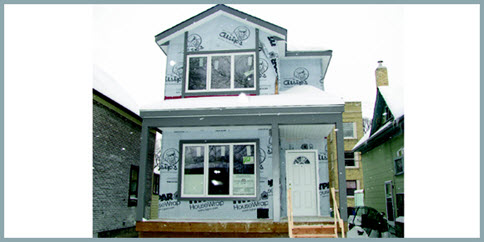With the current review of OurWinnipeg — the City of Winnipeg’s Master Plan for the next 25 years — and the development of a new residential infill strategy that addresses the need for additional housing for projected population growth, the issue of “Not In My Backyard”, or what is referred to as NIMBY, has never been more relevant.
In 2011, WinnipegREALTORS was a sponsor with the City of Winnipeg of a roundtable that hosted expert city planner Marni Cappe, author of Housing in My Backyard: A Municipal Guide for Responding to NIMBY, as well as past president of the Canadian Institute of Planners and currently serving on the board of directors of the Canadian Urban Institute. She spoke about how to deal with NIMBY issues as part of a strategy to encourage development within established neighbourhoods.
In her municipal guidebook, Cappe talks about how achieving affordable housing or new infill development can only happen through a collaborative process.
“One thing the public needs to understand,” she said, “is legislative frameworks and planning acts in Canada define municipal powers related to land use, and they do not support “people zoning”.
“Moreover, Canada is a signatory to the international convention on the right to adequate housing which is tied to the principle of non-discrimination. The Human Rights Commission has made it very clear it is explicitly against NIMBY-ism where it interferes with a person’s right to housing.
“As the city that is home to the Canadian Museum for Human Rights, it becomes obvious that it is unacceptable to discriminate against people based on their ethnicity, religion, skin colour, physical/mental abilities or even social class, be it income-related or property type-based ( e.g. renters).”
Another aspect of NIMBY that Cappe covered in her presentations was the fear of change. “Some residents are uncomfortable with change of any sort, let alone new development in their area,” she said. “What they forget is over a period of time, even slower growth cities like Winnipeg, have changed fairly dramatically.” If one sees the degree of substantial development of Main Street between 1887 and 1950, it would be unreasonable not to expect it to occur again as we plan to accommodate another 180,000 new residents requiring 83,000 new housing units in the next 20 years.
Cappe stated that existing neighbourhoods expecting to remain “frozen in time,” while new or future developments on the periphery of the city take up all the new demand, is unrealistic both from a capacity and infrastructure cost point of view. Intensification of existing infrastructure will be required, especially along routes designated as major public transit corridors where less reliance on cars is possible.
Cappe explained that her guidebook includes 32 strategies/techniques and seven case studies to showcase recent municipal NIMBY experience. Her five main themes are legislative frameworks (e.g. municipal legislation, planning acts), planning tools (e.g. municipal plans and zoning by-laws), community engagement/communication, educational tools, and monitoring and implementation.
Regarding legislative frameworks, Cappe emphasized municipal officials and politicians need to take a leadership role in upholding and stating the importance of the legal basis for allowing housing, and remain firm on compliance with human rights legislation that prohibits discrimination. She said officials should insist on respectful comments at public meetings with zero tolerance for discriminatory remarks.
As is happening in Winnipeg with its OurWinnipeg Complete Communities Direction Strategy, which outlines future areas of intensified development, planning tools offer municipalities the ability to set out comprehensive and long-range plans to establish future growth patterns and development. Cappe said that zoning by-laws and more detailed site plans are partners in the success of new developments. Developers that are attuned to the city’s overall planning direction and guidelines will have a much better chance of overcoming NIMBY sentiment and opposition.
Cappe added that the integration of land use and infrastructure planning (e.g. rapid transit) is important in building a case for higher density when addressing traffic issues. In addition, well thought out design guidelines around infill and intensification policies illustrate how it can be done in a manner that will not detract from the character and form of the existing neighbourhood.
With this opportunity to educate through websites, blogs etc., this is a great way to provide access to as much information as possible. Cappe said this starts with a broader approach illustrating the importance of local community growth and housing challenges, and then expands into a site specific proposal.
Cappe pointed out that the City of Ottawa has developed a planning primer course for its citizens. Residents can learn about the legislative framework and policy basis upon which land use decisions are made, as well as more specialized areas such as transit planning and urban design.
According to Cappe, implementing and monitoring is essential to gaining credibility in delivering on what was promised and stated throughout the development process, as well as establishing trust within a community.
Winnipeg can learn from planning experts such as Marni Cappe, and cities like Ottawa and Edmonton, which have enjoyed successful infill development through adopting a manual of planning and design guidelines for residential infill in mature neighbourhoods.
As per OurWinnipeg’s Complete Communities direction strategy, developing our own guidelines for residential infill development will be critical to our success in creating more housing within existing communities.



